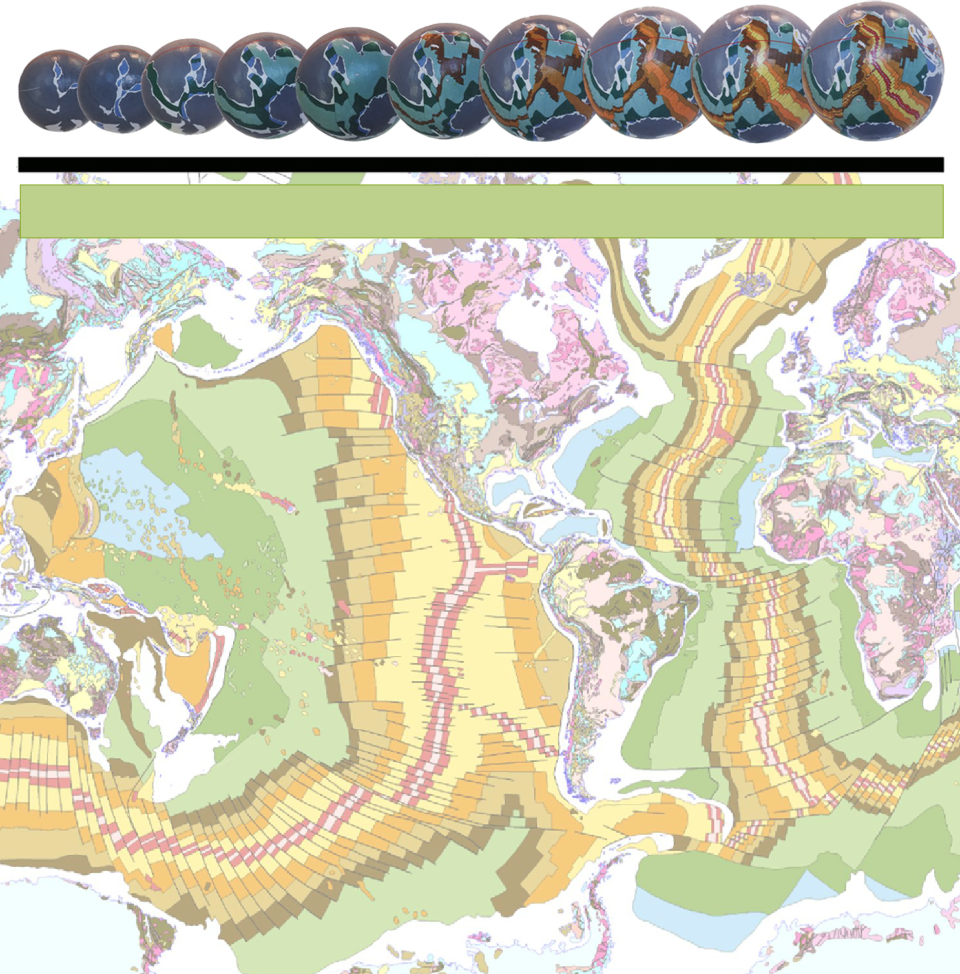

FACT OR MERE COINCIDENCE?
Expansion Tectonic modelling studies outlined here utilise modern geological mapping published by the Commission for the Geological Map of the World and UNESCO (1990) to constrain plate assemblages on small Earth models. This mapping was not available to early researchers into continental drift, plate tectonics, or Earth expansion.
It is important to note that this map was originally commissioned and completed in order to quantify the plate motion histories and plate assemblages on a constant radius plate tectonic Earth. However, this map is rarely used in plate tectonic studies today simply because it failed to achieve this intended aim.
The Expansion Tectonic modelling studies presented here demonstrate conclusively that assemblage of each of the crustal plates on small Earth models coincide fully with the seafloor spreading and geological evidence and accord precisely with the ancient Earth radii derived from measured surface areas. This coincidence applies not only to the more traditional oceans, such as the Atlantic Ocean where conventional reconstructions agree in principle, but also to the Pacific Ocean where the necessity for subduction of all or part of the seafloor crusts generated at spreading ridges is refuted.
It is emphasised that this published Geological Map of the World is factual evidence and the Expansion Tectonic modelling and research undertaken can therefore be justly considered as empirical research. The most fundamental question considered during this research was:
Does the seafloor mapping really reflect an increase in Earth radius with time?
This question was dually answered and tested by measuring each of the seafloor surface areas in turn and from this, calculating ancient Earth radii for each interval of time back to the Triassic Period. These results were then further quantified by using the radii data to create small Earth models. These models were in turn used to test whether or not the remaining seafloor and continental crustal plate data will reassemble back in time to ultimately assemble as Pangaea and primordial Archaean supercontinental small Earth models respectively.
By progressively removing each coloured seafloor stripe in turn it is shown that the plate fit-
This unique fit-
Quantification of an Expansion Tectonic Earth process back to the early-
Moving back in time, any crustal extension must then be progressively restored to a pre-
During this crustal restoration process, the spatial integrity of all existing ancient cratons and orogens was retained until further restoration to a pre-
This primordial Earth comprises an assemblage of the most ancient Archaean cratons and Proterozoic orogenic rocks: all other rocks were simply returned to their places of origin.
Mathematical modelling of both the seafloor and continental crustal surface area data demonstrates that the Earth is undergoing an exponential increase in surface area and radius, commencing from a primordial Earth of approximately 1,700 kilometres radius during early-
The calculated rate of increase in Earth radius throughout the Archaean to mid-
The evolution of the supercontinents during pre-
From this small Earth modelling exercise it was shown that, prior to the Triassic Period, the ancient supercontinents existed as a complete supercontinental crustal shell for approximately 94 percent of early Earth history, lasting for some 3,750 million years. This supercontinental crust covered the entire Earth with no large intervening oceans.
Crustal assemblages on each of the small Earth models also shows that large conventional Panthalassa, Tethys, and Iapetus Oceans are not required during reconstruction. These oceans are instead replaced by continental Panthalassa, Iapetus, and Tethys Seas, which represent precursors to the modern Pacific and Atlantic Oceans as well as ancient sedimentary basins located on many of the present-
Fundamental to the concept of Expansion Tectonics is the premise that the volume of ocean waters and atmospheric gases has been accumulating throughout time in sympathy with the formation of ancient supercontinental crusts and extrusion of new seafloor volcanic lava along the mid-